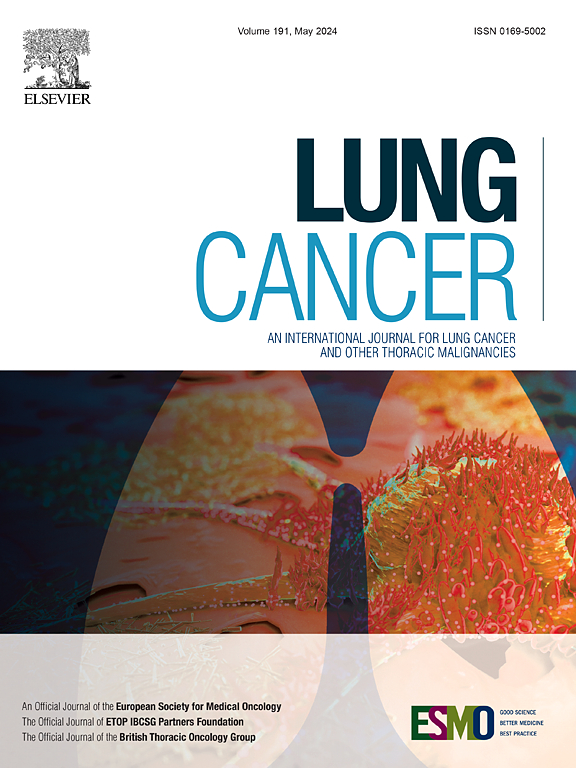Professional-patient discrepancies in assessing lung cancer radiotherapy symptoms: An international multicentre study
IF 4.5
2区 医学
Q1 ONCOLOGY
引用次数: 0
Abstract
Background and purpose
We investigate discrepancies in the assessment of treatment-related symptoms in lung cancer between healthcare professionals and patients, and factors contributing to these discrepancies.
Materials and methods
Data from 515 participants in the REQUITE study were analysed. Five symptoms (cough, dyspnoea, bronchopulmonary haemorrhage, chest wall pain, dysphagia) were evaluated both before and after radiotherapy. Agreement between healthcare professionals and people with lung cancer was quantified using Gwet’s-AC2 coefficient. The influence of clinical variables, comorbidities, and quality-of-life outcomes on agreement was examined through stratified analyses.
Results
We found varying levels of agreement between healthcare professionals and people with lung cancer. Bronchopulmonary haemorrhage and dysphagia exhibited very good agreement (meanAC2 > 0.81), while cough and chest wall pain showed substantial agreement (meanAC2 = 0.64 and 0.76, respectively). Dyspnoea had the lowest agreement (meanAC2 = 0.59), with prior chemotherapy significantly reducing agreement levels. Chronic obstructive pulmonary disease (COPD) and early cancer stages also contributed to discrepancies in dyspnoea assessments. Regarding quality-of-life, the most relevant factor was fatigue, which reduced agreement in the assessment of dyspnoea (AC2 = 0.55 vs 0.70), dysphagia (AC2 = 0.48 vs 0.69), cough (AC2 = 0.58 vs 0.82), and chest wall pain (AC2 = 0.77 vs 0.91).
Conclusions
Our findings indicate strong alignment between healthcare professionals’ and people with lung cancer evaluations of observable treatment-related symptoms, but less consistency for subjective symptoms such as dyspnoea. Factors such as prior chemotherapy, COPD, and cancer stage should be considered when interpreting symptom assessments. Furthermore, our study underscores the importance of integrating quality-of-life considerations, particularly fatigue, into symptom evaluations to mitigate potential biases in symptom perception.
评估肺癌放疗症状的专业患者差异:一项国际多中心研究
背景和目的:我们调查医疗保健专业人员和患者对肺癌治疗相关症状评估的差异,以及导致这些差异的因素。材料和方法:对来自515名REQUITE研究参与者的数据进行分析。放疗前后观察5种症状(咳嗽、呼吸困难、支气管肺出血、胸壁疼痛、吞咽困难)。使用Gwet - ac2系数量化卫生保健专业人员与肺癌患者之间的一致性。通过分层分析检查临床变量、合并症和生活质量结果对一致性的影响。结果:我们发现医疗保健专业人员和肺癌患者之间存在不同程度的一致性。支气管肺出血和吞咽困难表现出非常好的一致性(平均ac2为0.81),而咳嗽和胸壁痛表现出相当大的一致性(平均ac2分别为0.64和0.76)。呼吸困难的一致性最低(平均ac2 = 0.59),既往化疗显著降低一致性水平。慢性阻塞性肺疾病(COPD)和早期癌症阶段也导致了呼吸困难评估的差异。关于生活质量,最相关的因素是疲劳,这降低了评估呼吸困难(AC2 = 0.55 vs 0.70)、吞咽困难(AC2 = 0.48 vs 0.69)、咳嗽(AC2 = 0.58 vs 0.82)和胸壁痛(AC2 = 0.77 vs 0.91)的一致性。结论:我们的研究结果表明,医疗保健专业人员和肺癌患者对可观察到的治疗相关症状的评估有很强的一致性,但对主观症状(如呼吸困难)的评估一致性较低。在解释症状评估时,应考虑诸如既往化疗、慢性阻塞性肺病和癌症分期等因素。此外,我们的研究强调了将生活质量考虑因素,特别是疲劳,纳入症状评估的重要性,以减轻症状感知中的潜在偏差。
本文章由计算机程序翻译,如有差异,请以英文原文为准。
求助全文
约1分钟内获得全文
求助全文
来源期刊

Lung Cancer
医学-呼吸系统
CiteScore
9.40
自引率
3.80%
发文量
407
审稿时长
25 days
期刊介绍:
Lung Cancer is an international publication covering the clinical, translational and basic science of malignancies of the lung and chest region.Original research articles, early reports, review articles, editorials and correspondence covering the prevention, epidemiology and etiology, basic biology, pathology, clinical assessment, surgery, chemotherapy, radiotherapy, combined treatment modalities, other treatment modalities and outcomes of lung cancer are welcome.
 求助内容:
求助内容: 应助结果提醒方式:
应助结果提醒方式:


